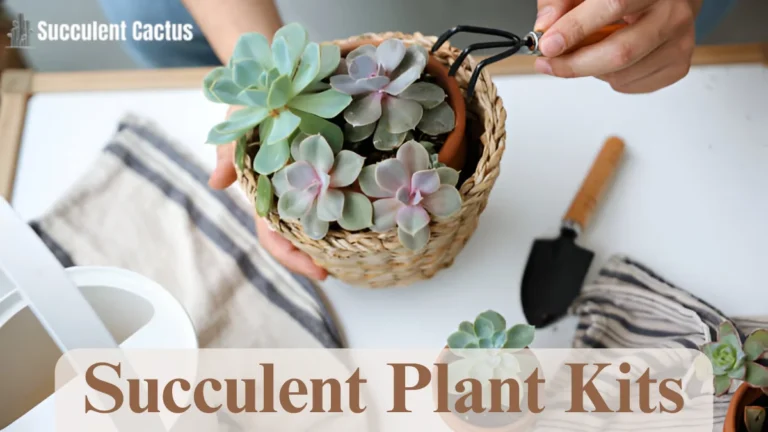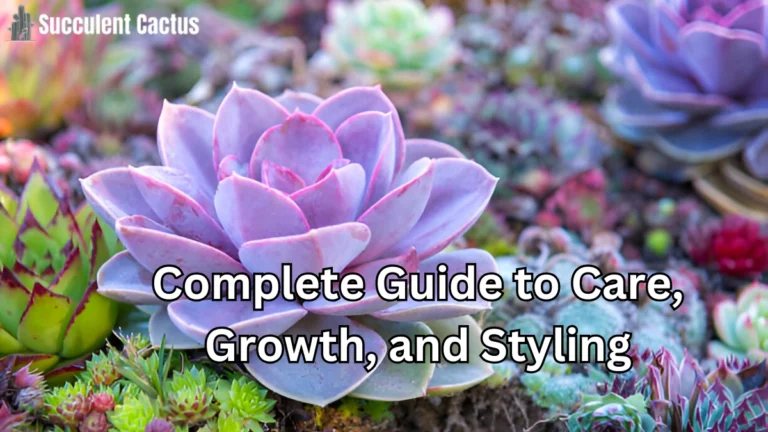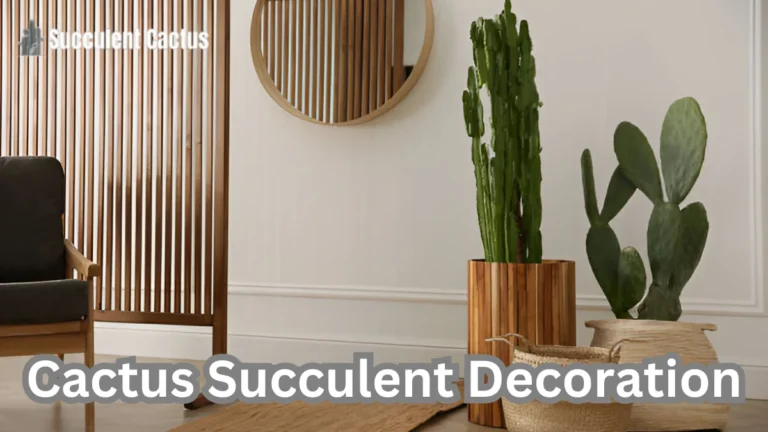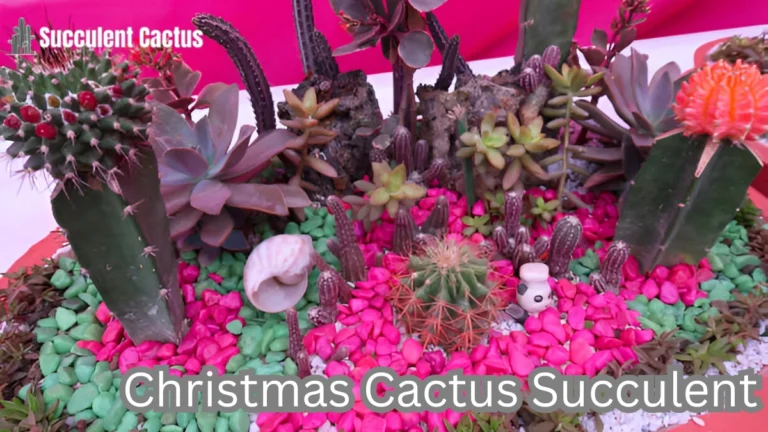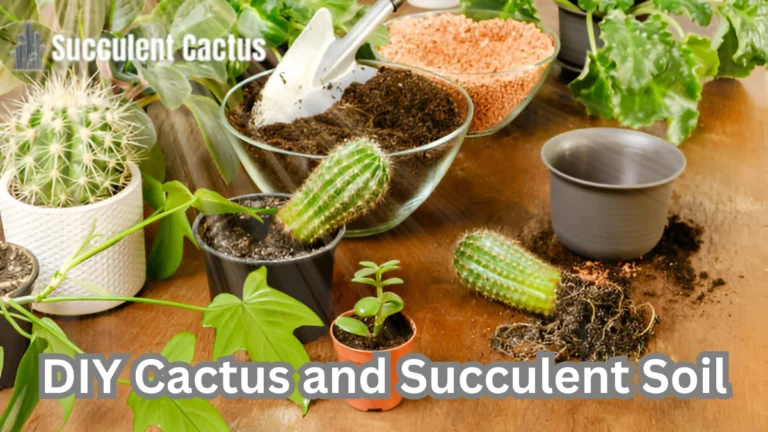The Lifespan of Succulent Cacti: How Long Do Cactus and Succulent Plants Live?

Succulent cacti are some of the most resilient and low-maintenance plants, often thriving in harsh environments. But just how long do these tough plants live? The succulent cactus lifespan can vary significantly depending on various factors like species, care, and environmental conditions. In this comprehensive guide, we’ll dive deep into understanding the lifespan of succulent cacti, the factors influencing it, and how you can ensure your cactus thrives for decades.
1. Understanding the Lifespan of Succulent Cactus
The Average Lifespan of Succulent Cactus
Succulent cacti are long-living plants, with some species capable of surviving for several decades or even centuries under the right conditions. On average, a well-cared-for cactus can live anywhere from 10 to 200 years, depending on the species. The average lifespan of succulent cactus can be influenced by several environmental factors such as temperature, soil, and water availability.
For example, the Saguaro cactus, a well-known succulent, can live for over 150 years, while smaller cacti species may have a lifespan of 10-30 years. The Barrel cactus, another popular species, has a lifespan of around 50-75 years in the wild.
Factors Affecting the Lifespan of Succulent Cactus
The lifespan of succulent cacti is influenced by various factors, including environmental conditions, proper care, and the species itself. Factors like watering, sunlight, temperature, and soil quality all play critical roles in how long a cactus lives. In the right conditions, many cacti will not only survive but thrive for many years.
Additionally, the cactus’s ability to store water in its tissues contributes to its long lifespan. In environments with little rainfall, cacti can survive for long periods without water, making them ideal for arid regions.
The Importance of Species in Lifespan
Different species of cacti have vastly different lifespans. For instance, some smaller species like the Pincushion cactus have a relatively short lifespan, while larger species like the Saguaro and Prickly Pear can live much longer. Understanding the species you own is essential for managing expectations and providing optimal care.
2. How Cactus Lifespan is Affected by Care and Environment
Proper Care and Its Impact on Longevity
The care you provide directly affects the health and lifespan of your cactus. Cacti that receive proper sunlight, are watered according to their needs, and are planted in the correct soil tend to live longer. Additionally, the size of the pot, the quality of the water, and even the occasional pruning play a role in maintaining a cactus’s vitality.
- Watering: Overwatering or underwatering can significantly reduce the lifespan of cacti.
- Soil: Proper drainage is crucial to prevent root rot, which can drastically shorten a cactus’s life.
- Sunlight: Cacti need plenty of sunlight to thrive. Insufficient light can cause slow growth, poor health, and a shortened lifespan.
Environmental Conditions and Lifespan
Cacti are highly adaptable to various environmental conditions, but they do best in dry, warm climates. In regions with low humidity and plenty of sunshine, cacti can thrive for decades. Extreme cold or frost can be deadly for many cacti, as they are not adapted to survive freezing temperatures.
A cactus in a garden or outdoor setting will often live longer if planted in its natural environment. Indoor cacti, on the other hand, may need additional care to mimic the sun and warmth they would receive in the wild. Temperature fluctuations and the amount of sunlight they get can directly affect how long they live.
The Role of Disease and Pests
Cacti are relatively resistant to pests, but they are not invincible. Diseases like root rot, fungal infections, and mealybugs can shorten a cactus’s lifespan if not treated promptly. Regularly inspecting your cactus for pests and signs of infection, along with using appropriate treatments, can extend its life.
3. How Watering Affects the Lifespan of Cacti
The Importance of Proper Watering Techniques
Watering is one of the most crucial aspects of cactus care. Cacti are desert plants adapted to survive in environments with little rainfall. Overwatering is a common mistake, and it can lead to root rot and other diseases that shorten the cactus’s lifespan.
- Soak and dry: The best practice for watering cacti is to thoroughly soak the soil and allow it to dry out completely before watering again. This mimics the natural conditions cacti experience in the wild, where rainfall comes in bursts followed by long dry spells.
- Watering frequency: Cacti typically need to be watered once every 2-4 weeks during the growing season, and much less during their dormant period (typically winter).
Signs of Overwatering and Underwatering
- Overwatering: The roots of the cactus may begin to rot, leading to mushy, yellowed, or soft spots on the cactus. If left unchecked, overwatering can kill the cactus.
- Underwatering: Cacti that are underwatered may show signs of wrinkling, shriveling, or fading colors. While cactus can survive long dry periods, consistent underwatering may lead to permanent damage and shortened lifespan.
The Impact of Water Quality
The water quality used to hydrate your cactus also plays a role in its longevity. Tap water often contains minerals and chemicals that may not be ideal for cactus health. Using filtered water or rainwater can help keep your cactus thriving.
4. Understanding Growth Stages of Cactus Plants
The Juvenile Stage
The juvenile stage of a cactus typically lasts for the first few years of life, depending on the species. During this phase, cacti are more vulnerable to diseases, pests, and adverse environmental conditions. They require more frequent care to ensure they establish strong roots and begin to grow effectively.
During this stage:
- Watering: Keep soil moderately moist.
- Light: Provide full sunlight, especially as they begin to mature.
- Soil: Use well-draining soil to prevent root rot.
The Mature Stage
Once cacti reach their mature stage, their growth slows down, and they can survive with less frequent care. At this point, the cactus will have built a strong root system, and its watering needs decrease. Some species of cactus may also begin to bloom during this stage.
- Watering: Water less frequently, allowing the soil to dry out fully.
- Sunlight: Ensure continued access to plenty of sunlight for optimal health.
- Pruning: Occasional pruning may help with shaping and maintaining cactus health.
The Decline Stage
Like all living organisms, cacti eventually enter a decline stage. During this stage, the plant may show signs of aging, such as slower growth or diminished health. While some cacti may continue to thrive for many years even in their decline, others may need to be replaced if they show signs of severe damage or decay.
5. Common Cactus Species and Their Lifespan
Saguaro Cactus (Carnegiea gigantea)
The Saguaro cactus is one of the most iconic cacti species, known for its tall, tree-like appearance. This cactus can live for over 150-200 years. The Saguaro is a slow-growing plant and may take up to 10 years to reach just a few feet tall. However, once it matures, it can live for centuries if the environmental conditions are right.
Barrel Cactus (Ferocactus)
The Barrel cactus is another popular species, with a lifespan of 50-75 years. It is typically round and spiny, growing slowly over time. Barrel cacti thrive in arid desert environments and are known for their ability to store water, making them hardy plants.
Prickly Pear Cactus (Opuntia)
The Prickly Pear cactus has a much shorter lifespan compared to other cacti, generally living for about 20-30 years. Known for its flat pads and edible fruit, the Prickly Pear is one of the most adaptable and widespread cacti species. Despite its shorter life, it is a low-maintenance plant that grows in a variety of conditions.
6. Climate and Temperature Effects on Cactus Lifespan
Heat and Sunlight Requirements
Cacti thrive in warm, sunny environments. Excessive heat is not usually a problem for cacti; they are well-adapted to desert-like conditions. However, they do require access to plenty of direct sunlight for optimal growth. Lack of sunlight can reduce their lifespan and stunt their growth.
Cold and Frost Exposure
Cold temperatures and frost are the biggest threats to the lifespan of a cactus. Most cacti species are not frost-tolerant, and freezing temperatures can cause the cactus tissues to break down, leading to damage or death. Cacti grown in non-desert climates may require extra care during colder months, including bringing them indoors or providing frost protection.
Ideal Temperature Range for Cactus
The optimal temperature for cacti is between 70°F (21°C) and 100°F (38°C) during the daytime, with nighttime temperatures dropping to around 50°F (10°C). Ensuring that your cactus stays within this range can extend its lifespan significantly.
7. How to Maximize the Lifespan of Your Succulent Cactus
Proper Potting and Repotting Techniques
Repotting your cactus every few years ensures it has ample room for growth. A well-draining pot is essential to prevent overwatering. Use cactus-specific soil or a mixture of sand and peat to allow for proper drainage.
- When to Repot: Repot your cactus when it has outgrown its pot or if the soil has degraded.
- Pot Size: Choose a pot that is only slightly larger than the current one, as too much extra space can lead to overwatering.
Avoiding Overwatering and Underwatering
As discussed earlier, overwatering and underwatering are the biggest threats to a cactus’s lifespan. Be mindful of your cactus’s water needs, adjusting for the seasons and temperature changes. Always allow the soil to dry out completely between waterings.
Ensuring Proper Sunlight Exposure
Cacti need full sunlight to thrive. Place your cactus in a location that receives plenty of direct sunlight, especially during the growing season. If you’re growing cactus indoors, consider using a grow light to supplement natural sunlight.
9. Cactus Lifespan and Growth Speed
How Long Does it Take for Cacti to Grow?
Cacti are known for their slow growth, and the time it takes for them to mature can vary widely depending on the species. Smaller cacti, like the Pincushion cactus, may take a few years to grow just a few inches, while larger species such as the Saguaro cactus can take decades to reach full maturity. On average, cacti grow at a rate of 1-3 inches per year.
- Growth Rate Table:
| Cactus Species | Average Growth Rate | Time to Reach Maturity |
| Saguaro Cactus | 1-2 inches per year | 50-100 years |
| Barrel Cactus | 3 inches per year | 50-75 years |
| Prickly Pear Cactus | 4-6 inches per year | 10-20 years |
| Pincushion Cactus | 0.5-1 inch per year | 3-5 years |
The growth rate is heavily influenced by soil quality, water availability, and light exposure. Cacti growing in poor soil or with inadequate sunlight will grow at a much slower pace, and may even experience stunted growth.
Factors Influencing Cactus Growth Speed
- Watering: Proper watering can speed up the growth process. However, too much water can lead to root rot, which hinders growth.
- Light: Cacti require full sunlight to grow efficiently. Lack of sunlight can slow their growth dramatically.
- Temperature: Cacti generally grow faster in warmer temperatures (between 70°F and 100°F). Extreme cold can stunt their growth or cause dormancy.
Tips for Promoting Faster Growth
- Provide optimal sunlight (at least 6 hours a day).
- Use well-draining cactus soil to prevent root rot.
- Keep the temperature warm (between 70-100°F), especially during the growing season.
10. The Role of Fertilization in Cactus Lifespan
Importance of Fertilizer for Healthy Cacti
Fertilizing cacti is essential for ensuring that they receive the necessary nutrients for growth and long life. Cacti, while low-maintenance, do need regular feeding to stay healthy and to encourage optimal growth, especially during their growing season (spring and summer).
Choosing the Right Fertilizer for Cacti
When selecting a fertilizer for cacti, it’s crucial to pick one formulated specifically for cactus plants. Cactus fertilizers are typically high in potassium and phosphorus but low in nitrogen, which promotes flowering and root development rather than excessive foliage growth.
- Cactus Fertilizer Recommendations:
| Type of Fertilizer | Composition | Benefits for Cacti |
| Liquid Fertilizer | 10-10-10 | Fast absorption, ideal for quick growth |
| Slow-Release Fertilizer | 8-10-10 | Steady nutrient release reduces the risk of over-fertilizing |
| Organic Fertilizer | Variable | Eco-friendly, helps with soil aeration |
How to Apply Fertilizer for Maximum Effectiveness
Apply fertilizer only once a month during the growing season. Over-fertilizing can cause salt buildup, which can harm the roots. For best results, dilute liquid fertilizers to half strength to avoid burning the roots. Avoid fertilizing during the dormant season (typically in the winter), as cacti need rest.
11. The Impact of Pruning on Cactus Lifespan
Why Should You Prune Cacti?
Pruning is an essential part of cactus care, especially for maintaining health and shaping the plant. Regular pruning can help remove dead or damaged parts, which could otherwise lead to infections or pests. It also promotes better air circulation and light penetration, leading to a healthier cactus.
- Benefits of Pruning:
- Prevents disease and pest infestation.
- Improves cactus shape and growth.
- Helps manage the size of your cactus, especially for indoor plants.
Best Time to Prune Cacti
The best time to prune your cactus is during the growing season (spring and summer). This allows the cactus to heal quickly and avoid stress. Avoid pruning during the winter when the cactus is dormant, as this can cause unnecessary harm.
Pruning Techniques for Different Cacti Species
- Prickly Pear: Use gloves to carefully remove pads that have grown too large. Cutting back excess pads encourages the plant to focus energy on new growth.
- Saguaro: These cacti require careful pruning due to their large size. It is recommended to hire a professional to prune them if needed.
- Barrel Cactus: Prune away any dead, brown sections. Avoid cutting too much of the plant to ensure it continues to thrive.
12. Growing Cacti from Seed to Extend Lifespan
The Benefits of Growing Cacti from Seed
Growing cacti from seed can be a rewarding experience and offers the potential for longer-term growth. Starting from seed gives you the ability to control every aspect of the plant’s development, leading to healthier, longer-living plants. It also allows for more variety, as you can grow rare or hard-to-find species.
- Seed Growing Advantages:
- Control over growth conditions.
- Opportunity to grow a wide variety of cacti.
- Increased potential for longer lifespan if cared for properly.
How to Grow Cacti from Seed
Growing cacti from seed requires patience and a few key steps:
- Select your cactus seeds from a reputable source.
- Prepare a well-draining soil mix, preferably cactus mix or sand and perlite.
- Plant seeds about 1/4 inch deep and lightly press them into the soil.
- Keep the soil slightly moist and place the seed tray in a warm location with indirect sunlight.
- Once the seeds germinate (usually within 2-6 weeks), transplant the seedlings into individual pots.
- Growing Cacti from Seed Table:
| Cactus Species | Germination Time | Temperature Requirement | Potting Time (after germination) |
| Saguaro Cactus | 3-6 weeks | 70°F-80°F (21°C-27°C) | 3-4 months |
| Prickly Pear Cactus | 1-3 weeks | 75°F-85°F (24°C-29°C) | 2-3 months |
| Barrel Cactus | 2-4 weeks | 70°F-85°F (21°C-29°C) | 2-3 months |
Challenges in Growing Cacti from Seed
Growing cacti from seed can be tricky, as young seedlings are fragile and require constant care. The process may take years before they become mature plants. It’s important to manage moisture, light, and temperature conditions carefully to avoid damping off or other diseases.
FAQs
Q:1 How long do cactus succulents live?
Ans: Most cactus succulents can live anywhere from 10 to 200 years, depending on the species and care.
Q:2 What is the best way to water my cactus?
Ans: Water your cactus deeply but infrequently, ensuring the soil dries out completely between waterings.
Q:3 How can I tell if my cactus is getting too much water?
Ans: Signs of overwatering include soft, yellowing, or mushy spots on the cactus.
Q:4 Can I grow a cactus indoors?
Ans: Yes, many cacti can be successfully grown indoors with the right care, such as adequate sunlight and temperature.
Q:5 What temperature is best for cacti?
Ans: Cacti thrive in temperatures between 70°F and 100°F (21°C to 38°C), with nighttime temperatures around 50°F (10°C).
Conclusion
The succulent cactus lifespan is influenced by many factors, including species, care, and environmental conditions. By providing the right care, including proper watering, ample sunlight, and maintaining an optimal environment, you can ensure your cactus lives a long, healthy life. Whether you own a Saguaro, Barrel, or Prickly Pear cactus, understanding the specific needs of your plant is the key to extending its lifespan and enjoying it for many years to come.

